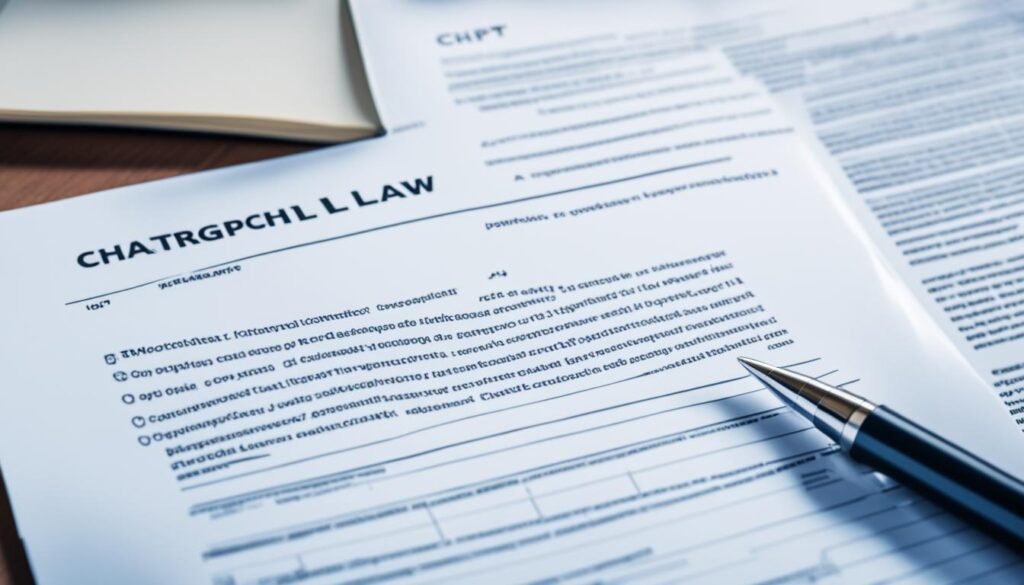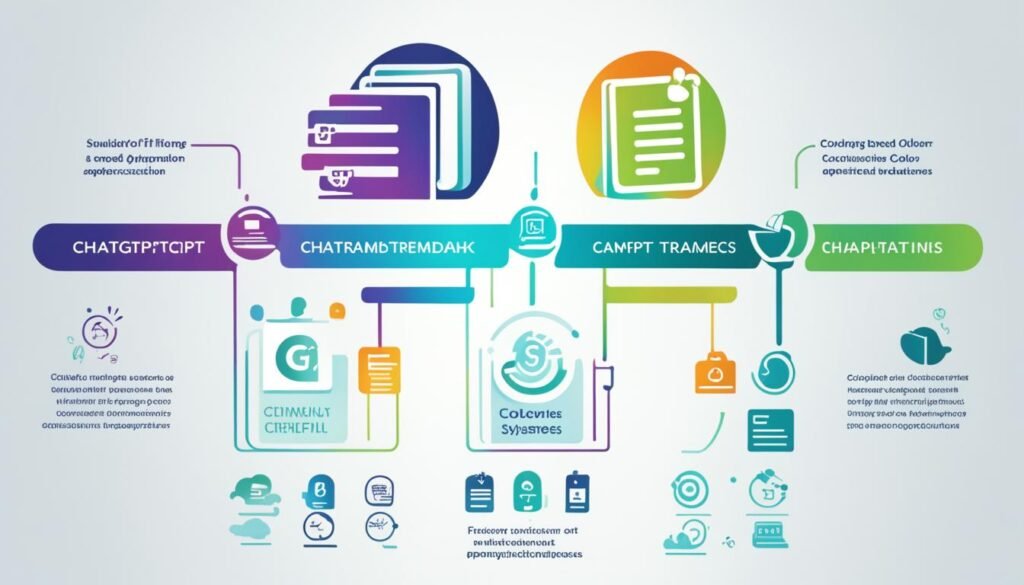In today’s world, using AI tools like ChatGPT for trademark and copyright applications is key. Businesses need to protect their ideas, and ChatGPT helps make this easier. It can quickly and accurately put together important documents. This makes filing trademarks and copyrights smoother for everyone.
ChatGPT is changing how we handle intellectual property filings. It cuts down on mistakes and makes things more efficient. This is good news for legal experts and regular people alike.
Key Takeaways
- AI tools like ChatGPT are becoming vital for intellectual property applications.
- Leveraging ChatGPT improves the accuracy of trademark and copyright filings.
- AI-assisted legal writing guide enhances the efficiency of the application process.
- Understanding how to use ChatGPT can simplify complex legal documentation.
- By reducing errors, AI tools save time and resources during the filing process.
Understanding Trademark and Copyright Applications
Protecting creative work is key, and knowing the difference between trademark and copyright applications is vital. Trademark applications protect things like names, logos, and slogans for goods or services. They help businesses stand out and make it clear to customers what they offer.
Copyright applications protect original works like literature, music, and art. They give creators the right to use and share their work. This stops others from copying or performing it without permission.
To file for trademarks and copyrights, you need to follow certain steps and meet specific requirements. For trademarks, you must fill out forms, prove you’re using the mark in business, and check for any trademark conflicts. Copyrights are simpler but still need the right paperwork to show what you created and who made it.
Here’s a quick overview of the key differences and processes involved:
| Aspect | Trademark Applications | Copyright Applications |
|---|---|---|
| Purpose | Protect brand identifiers | Protect original works of authorship |
| Examples | Logos, slogans, brand names | Books, music, films, paintings |
| Key Requirements | Forms, establishing first use, conflict identification | Forms, original work definition |
| Duration of Protection | Renewable every 10 years | Life of author + 70 years |
Understanding trademarks and copyrights is the first step in exploring IP laws and how to file effectively.
The Role of AI in Intellectual Property Law
AI technologies are changing the game in intellectual property law. They’re bringing a big shift to how legal work is done. Law firms now use AI to tackle tasks that used to take a lot of time and effort.
By using AI tools, firms can make legal documents faster and do research on a bigger scale. This means legal experts can focus on more important work.
AI helps with things like writing legal papers, managing IP rights, and keeping up with new laws. These tools save a lot of time and make sure legal work is more precise. This leads to smoother legal processes.
Law firms can use AI to understand trends and make smart decisions with data. This helps businesses manage their intellectual property better. As AI gets better, it will play an even bigger part in intellectual property law. This will make legal work more efficient and easy to get into.
How ChatGPT Can Assist in Legal Documentation
ChatGPT is a big help for those working on legal documents. It makes the process faster and more accurate. By creating clear and precise drafts, it helps meet the high standards needed for things like trademark and copyright applications.
ChatGPT is great at suggesting the right legal language for different situations. It uses smart algorithms to offer legal phrases that make sense and fit the context. This lets legal experts focus on big-picture tasks while AI writing tools for legal purposes handle the basics.
ChatGPT also helps with answering complex legal questions. It acts as a quick knowledge source, giving clear answers to legal topics. This is super useful in a busy legal world where time is critical. By automating legal writing, ChatGPT boosts productivity and makes sure documents are thorough and easy to understand.

Overall, ChatGPT makes legal documentation better. It not only raises the quality of drafts but also helps legal pros work more efficiently. Adding automating legal writing to daily work is a smart move that looks to the future of legal tasks.
How to Use ChatGPT for Completing Trademarks and Copyright Applications
Using ChatGPT to fill out trademarks and copyrights makes the process easier and faster. This guide shows how to use AI for legal documents for better results.
Step-by-Step Guide to Using ChatGPT
To use AI for trademark or copyright applications, follow these steps:
- Set Up the Tool: First, pick a platform that lets you use ChatGPT. Make sure you have a good internet connection and create an account if needed.
- Enter Relevant Information: Collect all the details you need for your trademark or copyright. This includes descriptions, classifications, and any sketches or designs.
- Generate Drafts: Then, use ChatGPT to make first drafts. Put in your info, and the AI will create content that meets the application needs.
- Review Outputs: Check the AI’s content for legal correctness. Look closely at the language, categories, and any legal terms needed.
Common Pitfalls and How to Avoid Them
ChatGPT can make things easier, but there are risks in using tech for legal work:
- Over-reliance on AI: Don’t just rely on AI. Always have a qualified lawyer check important documents.
- Inaccurate Data Entry: Make sure all info you give to ChatGPT is correct to avoid mistakes in the final documents.
- Neglecting Specific Requirements: Check local laws for specific filing needs. This ensures you follow the rules.
This method helps you use AI well for trademarks and copyrights applications.
| Step | Description |
|---|---|
| 1 | Set Up the Tool |
| 2 | Enter Relevant Information |
| 3 | Generate Drafts |
| 4 | Review Outputs |
AI-Powered Writing Tools for IP Filings
AI writing tools for IP have changed the way we handle intellectual property documents. These tools make filing for IP easier and faster. They help legal experts work more efficiently by automating many tasks. Many platforms offer special features for preparing and sending in trademark and copyright applications.
Let’s look at some top AI writing tools for IP filings:
| Tool Name | Key Features | Best For |
|---|---|---|
| TrademarkNow | Real-time trademark search, risk assessment. | Trademark searches and filings. |
| DocuSign | Electronic signatures, document management. | Signing and managing IP documents. |
| PatentOptimizer | Patent drafting, claim analysis. | Patent applications and revisions. |
| Equidam | Valuation tools, market insights. | Valuing IP assets. |
Using these AI tools can make legal work more productive. They automate many tasks in IP filings. This means legal experts can focus on more complex tasks. It also means they make fewer mistakes and have a better chance of success.
These technologies change how legal professionals handle their work. They make filing for IP more efficient and successful.
Benefits of ChatGPT for Trademark Applications
Using ChatGPT for trademark applications has many advantages. It makes the filing process smoother and more efficient. Businesses and individuals can use AI to improve their trademark filing process. This leads to better productivity and accuracy.
Enhancing Accuracy and Efficiency
One big plus of ChatGPT for trademarks is its accuracy. It checks data and gives advice to reduce mistakes. This AI tool works fast with lots of information, making filing trademarks more efficient.
It also gives feedback in real-time to avoid common mistakes. This lets applicants focus more on their business.
Cost-Effectiveness of AI-Assisted Filing
AI in trademark applications saves time and money on legal services. ChatGPT does a lot of the early work, so legal teams can focus on more important tasks. This makes using resources more efficient and saves money in the long run.
Businesses can use ChatGPT to make their trademark applications go smoothly and quickly.

| Benefit | Description |
|---|---|
| Increased Accuracy | Minimizes errors in filings through data analysis and recommendations. |
| Enhanced Efficiency | Speeds up the application process with real-time feedback. |
| Cost Savings | Reduces the need for extensive legal manpower, cutting costs. |
| Resource Allocation | Allows businesses to focus on core operations while managing trademark applications. |
ChatGPT for Copyright Registrations
ChatGPT makes copyright registrations easier and clearer. It uses AI to help with the process, making sure you follow the rules and understand your rights. This tech gives you the knowledge and tools you need to file for copyright correctly.
Streamlining the Application Process
ChatGPT can make applying for copyright much easier. No more getting lost in forms and rules. You get templates and advice that fit your needs. This means fewer mistakes and faster filing, thanks to the benefits of AI for copyright filing.
Using AI to Understand Copyright Laws
Copyright laws can be hard to get through, but ChatGPT helps clear things up. You can ask questions and get quick answers. This helps you understand copyright better and use AI in copyright applications wisely.
| Feature | Traditional Method | Using ChatGPT |
|---|---|---|
| Application Clarity | Often complex and subjective | User-friendly templates and explanations |
| Time Efficiency | Time-consuming with multiple revisions | Faster submissions with less error |
| Understanding of Copyright Laws | Dependent on legal advice | Immediate AI-driven insights and answers |
| Cost Implications | Potentially high due to legal fees | Cost-effective AI solutions available |
Natural Language Processing for IP Filings
Natural Language Processing (NLP) is key in intellectual property (IP) filings today. It helps machines understand human language, making interactions with IP offices more accurate and efficient. AI language tools for law make complex legal terms easier to understand, improving communication.
Using NLP in legal work makes creating legal documents easier. AI tools help with trademark and copyright applications, reducing mistakes. This technology saves time and makes submissions to IP offices better.
NLP also helps in finding patents or trademarks. For example, AI tools like ChatGPT can help refine patent searches. By setting search parameters and interpreting results, practitioners can make better filing decisions. This is explained in detail in this guide.
| Feature | Benefit |
|---|---|
| Enhanced Clarity | Reduces confusion and misinterpretation in legal language. |
| Time Efficiency | Accelerates the drafting and review process. |
| Search Precision | Improves accuracy in existing IP searches. |
| Cost-Effectiveness | Reduces costs associated with professional legal consultations. |
NLP is changing how legal work is done, making it more accurate and clear. It helps professionals use technology to improve their IP filings.
Conclusion
ChatGPT is changing the game in trademark and copyright applications. It makes legal work more accurate and efficient. This means filing documents is easier and less prone to mistakes.
Using AI like ChatGPT also saves money and makes things more accessible. As AI grows in trademark and copyright law, it’s making legal work smarter. We’ll see more people using AI to manage their intellectual property better.
We suggest using AI tools like ChatGPT for your intellectual property needs. It boosts productivity and helps you understand complex legal topics better. By using AI, you can keep up with the changing legal world and stay ahead.
